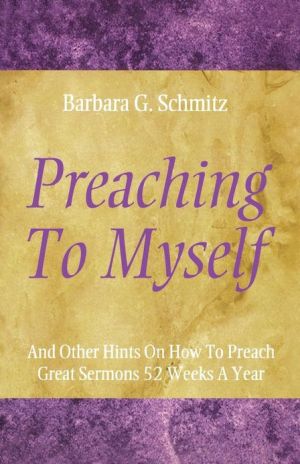

 |

|

The average rating for Preaching to Myself: And Other Hints on how to Preach Great Sermon 52 Weeks a Year based on 2 reviews is 3.5 stars.
Review # 1 was written on 2015-02-10 00:00:00 Stephen Willies Stephen WilliesGreat philosophically and practically! |
Review # 2 was written on 2019-04-13 00:00:00 Timothy Cooper Timothy CooperPagan Europe is a tricky subject to study, due to many factors such as Christian hostility (but Christian writers being the main source material). There are the limits of archaeology to study religion and lure of anthropology to study pagan religions from elsewhere in the world and assume they must have been the same as the place and time being studied. There is also the strong temptation to consider anything that seems a remnant of pagan times in a later period as an intact pure leftover of earlier times. Finally there is the political aspect. Neopaganism, even if a for the most part obscure movement, has a following in academic circles, ecological/feminist but also (ultra)nationalist western politics in that can influence any research on the subject. But I am happy to say that Hilda Davidson did not only for the most part avoid these traps but was fully aware of them and addressed them. The book is thematically divided on aspects of life (birth, death, hunting and so on) that had a goddess involved as part of the rituals involved, theology and as part of daily life. The approach is a for the most part functionalist one even if Davidson does borrow from other approaches such as cognitive structures, materialistic origins, identity and liminality. The idea is that there were many forms of goddess and they had many aspects linked to the daily lives of the communities were the goddess was part of the divine landscape. Such as the role of the goddess as helper during childbirth and the link with the midwives or the role of the goddess as weaver of destiny and the link with household weaving and the high status of royal women woven textiles. The relative importance of every aspect or type of goddess and need to please/respect her is linked according to Davidson, to the importance of the traits she represents in the communities of believers (the cult of the crops protector being less important in Iceland where little crops were grown or the high popularity of the celtic horse goddess Epona among European cavalry). However do not expect a straightforward description of every goddess with a neat defined list of traits and tasks and linked importance. Davidson painstakingly portrays the diversity of traditions, overlapping roles and fluidity of pagan worship and representations of the goddess(es). To Davidson the often at first glance confusing double nature of many of the goddess (both kind and cruel) is directly linked to the nature of things they watch over (childbirth brings life but can kill mothers, hunters hunt animals but are occasionally killed by the animals), so the darker side is not strange it might be the point of the cults, to be aware of the dangers involved and be prepared. Perhaps this could have been elaborated more upon, how this fluidity and perhaps more resigned attitude towards the divine and nature is different from the later Christian attitude toward the divine and the world and how a scientifically influenced mental approach to the world and parts of it such as agriculture differs from a pagan one. The link with later (Christian) Europe is twofold, at the one hand a emphasis on continuation of certain concepts of the role of the goddess(es) in saints, folk rituals and tales and on the other attempts to destroy these pagan inspired habits and open contempt. Davidson does not see these pagan like aspects as pure leftovers but as vague continuations and as a proof of the lasting impression the goddess in many forms has made on northern Europe as part of the preparations and framework of aspects of life. Something I did not like as much was the recurring habit of talking about southern European or even near east traditions, rituals and theology concerning goddesses. I did not feel like these added much to the book and in fact worsened the aspect of the book I did not like. I did not like the writing style or structure of the subchapters. Every subchapter was often little more then a list of goddess, theological stories and practices involved that often overwhelmed me as a wave of facts I found hard to find coherence in. But on the other hand it does showcase the diversity and flexibility involved in the subject. Even so I would have liked more in depth analysis or comparisons( both of which are already present but could have been expanded) and less descriptions. In Conclusion, it is a good book but you might have some difficulty to fully grasp the book and content if you are a novice to the subject of paganism, early medieval northern European history and anthropology. I recommend this to anyone interested and has a solid basis on the subjects mentioned above. |
CAN'T FIND WHAT YOU'RE LOOKING FOR? CLICK HERE!!!